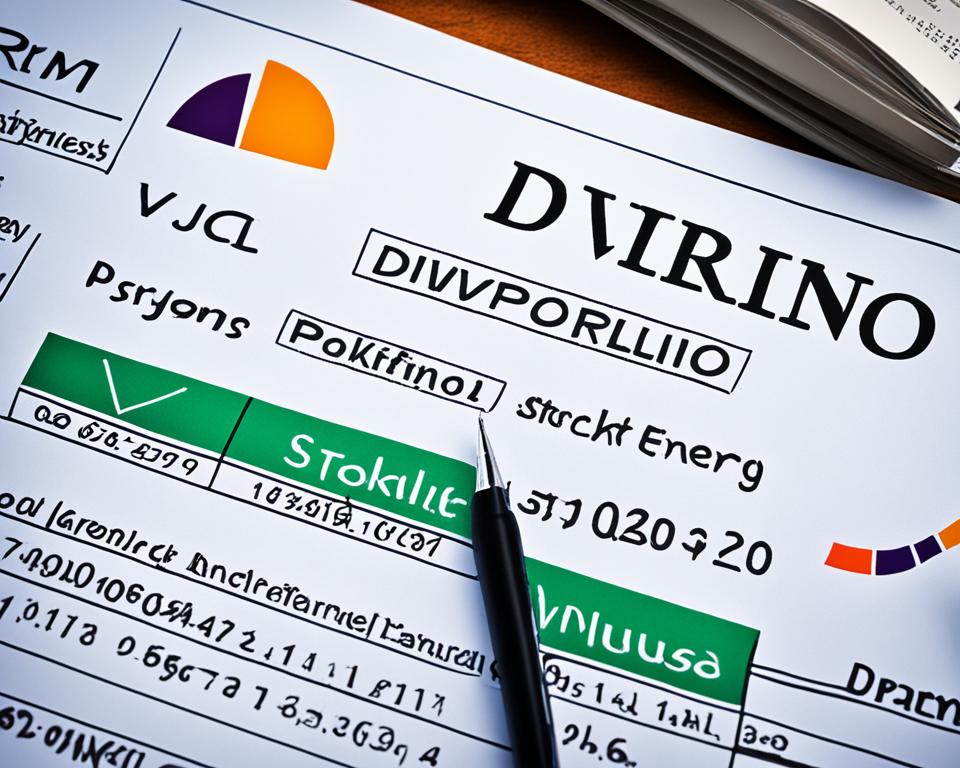The cornerstone of savvy financial planning often rests on the bedrock of a diversified investment portfolio. In the quest for financial stability and thriving capital growth, dividend investing emerges as a strategic ally. By infusing a steady stream of income into the mix, dividend-paying stocks not only reinforce your investment foundation but also pave the way for potential capital appreciation. It’s a dynamic approach to securing a financial future that marries the promise of steady income with the allure of long-term growth.
Key Takeaways
- Dividend investing is an integral part of building a diversified investment portfolio.
- Regular dividend payouts contribute to financial planning with a steady income.
- Investors benefit from potential capital growth alongside income generation.
- Stability during market turbulence can often be found in dividend-paying assets.
- Reinvesting dividends may compound wealth and fortify investment outcomes over time.
Understanding Dividend Investing
Dividend investing is a cornerstone of a robust investment strategy, offering a blend of regular income and potential for portfolio growth. Recognized for its strategic role in asset allocation, this approach garners particular interest from investors seeking not only investment diversification but also financial stability. Let’s delve deeper into what dividends are and how they play a pivotal role in shaping a diverse and secure investment portfolio.
The Basics of Dividends
At its core, the basic premise of dividends revolves around companies distributing a portion of their earnings back to their shareholders. This distribution reflects the company’s profitability and commitment to its shareholders, serving as a tangible reward for their investment. Not limited to mere cash payouts, dividends can also come in the form of additional shares, reinforcing an investor’s stake in the company.
Types of Dividends: Regular and Special
Dividends commonly manifest in two forms: regular dividends and special dividends. Regular dividends are predictable payments made to shareholders, adhering to a consistent schedule, and are seen as a reflection of a company’s stable earnings. On the other hand, special dividends are episodic, often stemming from unexpected financial wins or surges in profitability, serving as a bonus to shareholders on top of regular dividends.
| Dividend Type | Description | Frequency | Investor Expectations |
|---|---|---|---|
| Regular Dividends | Continuous, stable payouts reflecting consistent profits | Typically quarterly | Steady stream of income |
| Special Dividends | One-time payments following significant events | Irregular | Potential windfalls |
The Role of Dividends in an Investment Portfolio
The presence of dividends in an asset allocation strategy introduces a valuable layer of investment diversification. In the tapestry of an investment portfolio, the recurring revenue stream from dividends provides a buffer against market volatility, bolstering regular income for investors. This stability, often found in dividend-paying assets, ensures an added measure of security within a portfolio’s structure.
Understanding the mechanics of dividend payments and their impact on an investment portfolio makes clear why so many prioritize these assets in their long-term financial plans. As we progress, it’s essential to consider the nuanced roles that different forms of dividends play in fortifying an investor’s financial foundation against the unpredictable nature of the markets.
Dividend Stocks and Market Volatility
When navigating through the often tumultuous waves of the stock market, investors seek strategies that offer shelter from the storm of volatility. Dividend stocks hold a revered place in the arsenal of tools for risk management, contributing effectively to portfolio diversification. What sets these assets apart is their potential for lower volatility in contrast to their non-dividend-paying counterparts, and their strategic role in fortifying an investment portfolio against the unpredictability of the stock market’s ebb and flow.
Experienced investors know that dividends represent more than just regular payouts; they are signposts of a company’s financial health and a testament to its commitment to sharing profits with shareholders. In times of stock market volatility, these dividend payments become a cushion, softening the potential blows from sudden economic downturns. They afford a degree of predictability and reliability in income streams—attributes highly prized during uncertain financial climates.
By selectively channeling investments into dividend-paying stocks across diverse sectors, one can construct a well-rounded portfolio that stands resilient in the face of market shifts. Such strategic allocation is central to portfolio diversification, ensuring that an abrupt decline in one sector does not dictate the performance of an entire investment portfolio. Here’s a snapshot of how dividend stocks can serve as a stalwart guardian against market unpredictability:
- **Predictable Revenue**: Dividend stocks offer regular income, distinguishing them as less speculative and more conservative investment choices.
- **Market Resilience**: Companies with a consistent record of dividend payments often demonstrate resilience during economic downturns.
- **Sector Spread**: A portfolio that incorporates dividend payers from various industries mitigates the risk associated with overexposure to any single sector.
Diligently integrating dividend-paying stocks into one’s financial strategy does not guarantee immunity from the ups and downs of the stock market. However, it does signify a methodical approach towards mitigating risk, aiming for steady growth, and establishing a bulwark for one’s investments. In essence, dividends are not merely a passive income stream, but an active component of risk management. They provide a reassuring presence in the quest for portfolio diversification and play a critical role in tempering the impacts of stock market volatility.
Income Generation through Dividend Investing
Embarking on a journey of financial planning, investors often seek solid ground in the form of steady income streams. Dividend investing stands out distinctly in this landscape, presenting a dual benefit: the comfort of a steady paycheck and the potential for wealth accumulation through strategic portfolio diversification. Delving into the intrinsic value of dividends, we uncover how they can spice up the investment mix with a flavor of reliability and growth.

Regular Income Stream via Dividends
Dividends, often seen as the fruit of a wise investment, provide a consistent payout that enhances an investor’s financial scaffolding. Yielding a passive income, these regular disbursements emerge as an attractive feature for anyone aiming to complement their ventures with a predictable cash flow. Financial stability is fostered by this constant influx, playing a fundamental role in anchoring a diversified investment portfolio against the tumultuous tides of market fluctuations.
Impact of Dividend Reinvestment on Portfolio Growth
The allure of dividends is heightened when one considers the power of dividend reinvestment plans, commonly referred to as DRIPs. These schemes harness the magic of compound interest, inviting investors to reinvest their dividends into additional shares, thus setting the stage for exponential growth. The phenomenon forms a cornerstone in financial planning, offering investors a hands-off approach to increase their shareholding and, in turn, the magnitude of possible future payouts. It’s through this mechanism that dividends transform from mere income to a dynamic force in one’s investment advancements.
- Enhanced Purchasing Power: By reinvesting dividends, investors gradually amplify their stake in a company, potentially boosting the value of their portfolios.
- Compounding Wealth: As more shares are accumulated, the income generated from dividends can increase, driving a compounding effect that significantly upscales the worth of the investment over time.
- Long-Term Prosperity: DRIPs smoothen the path toward long-term financial goals, ensuring that the passive income today lays the groundwork for a more affluent tomorrow.
In the financial tableau, dividend investing is not simply a stroke of color but a masterstroke that adds depth and dimension to the canvas of investment portfolios. For those plotting their financial future, dividends offer a beacon, guiding towards a horizon where steady income streams and portfolio diversification converge to sow the seeds of enduring prosperity.
Dividend Investing as a Risk Management Tool
In the realm of personal finance, one cannot overstate the importance of risk management strategies to protect and grow one’s portfolio. Dividend investing stands out in this regard, offering investors a way to mitigate various financial risks. Let’s explore how harnessing the power of dividend-paying assets can serve as a bulwark against inflation risk and market risk, thereby enhancing the stature of a diversified investment portfolio.
Navigating Inflation Risk with Dividends
One of the most insidious threats to investment returns is inflation. As the cost of living rises, so does the necessity for investment strategies that outpace this increase to maintain the investor’s purchasing power. Dividend-paying stocks, especially those with a track record of growing their payouts, can offer a solution to combat the erosive effects of inflation.
Furthermore, dividends can provide investors with a tangible return that can be used to purchase additional assets or cover expenses, reducing the reliance on selling investments at potentially inopportune times. Here’s how dividends can offset inflation risk within a portfolio:
| Aspects of Inflation Risk | Role of Dividends |
|---|---|
| Erosion of Purchasing Power | Inflation-adjusted income through dividend growth |
| Fixed-Income Vulnerability | Dividend yields can surpass inflation rates |
| Market Timing Risks | Regular dividends reduce need for liquidation during market dips |
Market Risk Mitigation through Diverse Dividend Assets
When one considers market risk, the volatility of portfolio assets often comes to mind. Herein lies the advantage of diversifying one’s investments to include a spread of dividend-issuing companies across various sectors. This diversity helps in guarding against sector-specific downturns and broad market downturns, shielding the investor from concentrated losses.
A diversified investment portfolio that leverages dividend-paying stocks is like a well-balanced diet for financial health – it provides nourishment in the form of income and reduces the risk of ‘indigestion’ caused by market upheavals. Consider the following table as an illustration of how such a portfolio is structured for risk mitigation:
| Sector | Typical Dividend Yield | Influence on Risk Management |
|---|---|---|
| Utilities | 3% – 5% | Stability during economic shifts |
| Consumer Goods | 2% – 4% | Consistent performance in various market conditions |
| Healthcare | 1% – 3% | Defensive nature provides resilience |
| Technology | 1% – 2% | Growth potential with moderate income generation |
In conclusion, a strategic approach to dividend investing can significantly bolster risk management within the sphere of personal finance. By carefully curating a collection of dividend-paying assets, investors can effectively navigate the twin perils of inflation and market risk, asserting control over their financial destiny.
Assessing Dividend Safety and Financial Health of Companies
For investors aiming to fortify their portfolios with dependable income streams, assessing dividend safety and the financial health of companies is paramount. By scrutinizing these factors, one can discern the stability and sustainability of the dividends, ensuring that their investment options stand on solid ground. It is crucial to examine a variety of financial metrics which serve as indicators of a company’s enduring profitability and its potential for providing reliable dividends.
To evaluate dividend safety, one must look beyond the allure of high yields and delve into the company’s historical performance and financial statements. A history of consistent and growing dividends could reflect a business’s resilience and prudent financial management. In contrast, a high dividend yield might also be a red flag, signaling potential cash flow issues or a dividend at risk of being cut.
Key financial health indicators include earnings growth, low debt levels, strong cash flow, and sensible dividend payout ratios. A company with robust earnings growth and conservative debt levels is more favorable as it suggests a lower risk of dividend reduction in times of economic stress. Moreover, a healthy cash flow ensures that dividends are not merely a distribution of profits but also a comfortable part of the company’s financial strategy, reinforcing investment options with a safety net.
The table below provides an illustrative approach to how an investor can methodically assess the dividend safety and financial health of potential investment targets:
| Financial Metric | Purpose | Indicator of Financial Health |
|---|---|---|
| Earnings Growth | To measure the company’s profitability over time | Consistent growth suggests a sustainable dividend |
| Debt Levels | To evaluate financial leverage and risk | Low debt levels indicate lower financial strain |
| Cash Flow | To ensure the company’s capability to pay dividends | Strong cash flow supports continuous dividend payments |
| Dividend Payout Ratio | To determine the proportion of earnings paid as dividends | Lower payout ratios point to a buffer in volatile times |
Valuable resources such as The Value Line Investment Survey and corporate credit ratings offer an additional layer of insight when investigating a company’s financial standing. The Value Line Investment Survey provides analyses that can help anticipate future dividend actions, while credit ratings from agencies like Moody’s or S&P gauge the default risk and financial stability. Both resources are essential when considering which dividend stocks to integrate into a diversified portfolio.
In conclusion, thorough research and critical evaluation of dividend safety and financial health are vital for investors to protect and grow their capital. By including financially sound companies with reliable dividends, an investment portfolio becomes more resilient, capable of withstanding market vicissitudes and securing a stable income.
Balancing Yield and Growth in Dividend Investing
Successful dividend investing hinges on a delicate equilibrium between immediate income through dividend yield and prospective capital appreciation for total return. Astute investors must weigh these factors to cultivate a portfolio that not only satisfies short-term financial needs but also fosters long-term growth.
Yield vs. Total Return Considerations
The allure of high dividend yield is undeniable, as it offers investors an attractive immediate return on their investment mix. However, a broader perspective reveals the significance of total return, which encapsulates not only the immediate yield but the potential for stock price appreciation and dividend growth over time. This integrated view provides a comprehensive understanding of an investment’s performance and its impact on portfolio growth. The chart below illustrates the interconnectedness of yield and growth in the investment decision-making process:

Investors favoring a growth-oriented approach may veer towards companies with lower initial yields but with promising prospects for dividend increments and appreciation. As an investment matures, these companies can yield compounding benefits, enriching an investor’s portfolio with substantive growth.
Stability and Predictability of Dividend Payments
Exceeding the arithmetic of yield and returns is the pragmatic search for stability and predictability within dividend investing. Companies renowned for steady dividends are frequently associated with a strong financial health status, which manifests as regular, reliable payouts to shareholders. These companies are typically rooted in long-standing industries or sectors that offer a sense of security amidst the volatility of the market.
For portfolio diversification, such investments prove invaluable. They provide a dependable income stream and serve as a counterbalance to more volatile assets within the investment mix. The table below typifies the relationship between dividend stability, yield, and portfolio growth:
| Investment Type | Yield Profile | Stability Factor | Growth Potential |
|---|---|---|---|
| High Dividend Yield Stock | Attractive Immediate Income | Varies With Company Performance | Moderate to Low |
| Growth-Oriented Dividend Stock | Lower Initial Yield | High, with Steady Dividend Increases | High |
| Stable Blue-Chip Dividend Stock | Moderate and Consistent | High Predictability | Moderate |
It is essential for investors to assess both dividend metrics and company fundamentals to achieve the desired harmony between yield and growth. Balancing these elements judiciously can lead to sustainable portfolio growth and income generation, attuned to the unique financial objectives of every investor.
The Role of Dividend Aristocrats in Diversification
Within the echelons of financial strategies, one reliable beacon in the pursuit of portfolio diversification is the class of equities known as Dividend Aristocrats. These esteemed enterprises within the S&P 500 Index have distinguished themselves by increasing dividends for at least a quarter of a century in succession. This feat is more than a hallmark of stellar performance; it’s a testament to their resilience, disciplined management, and well-engineered business models.
The strategic incorporation of Dividend Aristocrats into an investment strategy is akin to constructing a financial edifice with fortified pillars. These companies, often leaders within their respective industries, command the ability to not only weather economic cycles but to emerge even stronger. As pillars of stability and predictors of growth, they offer investors a sense of confidence in steady, incremental returns.
The role that Dividend Aristocrats play in an investment portfolio extends beyond their emblematic status. Their propensity to consistently distribute increasing dividends renders these stocks a compelling option for those aiming to infuse their portfolios with resilient growth and income synergy. Here’s how these stalwarts aid in solidifying a diverse portfolio:
- **Resilience**: By virtue of their established presence and performance track record, these companies tend to remain robust against economic turbulence, sustaining shareholder confidence.
- **Growth**: As companies grow and expand, so do their dividends. Incorporating these stocks tends to contribute to the long-term appreciation of investment capital.
- **Sector Diversity**: Spanning multiple industries, Dividend Aristocrats diversify the risk profile, mitigating the potential impact of isolated sector downturns.
Embracing Dividend Aristocrats in one’s investment approach not only garners a slice of corporate success but also plots a course towards a more substantial and diversified revenue stream. The significance of this investment strategy is underscored by the robust framework it offers investors in crafting a balanced portfolio geared for both prosperity and peace of mind.
| Company | Sector | Years of Dividend Increases | Recent Dividend Yield |
|---|---|---|---|
| 3M | Industrials | Over 60 | Approx. 3% |
| Johnson & Johnson | Healthcare | Over 50 | Approx. 2.5% |
| McDonald’s | Consumer Discretionary | Over 40 | Approx. 2.3% |
| Procter & Gamble | Consumer Goods | Over 60 | Approx. 2.4% |
The inclusion of Dividend Aristocrats stands as a pivotal component of a well-honed investment strategy, cementing the overall objective of portfolio diversification. For investors with a gaze set firmly on enduring growth and progressive income, Dividend Aristocrats serve as not just a choice but a strategic imperative.
Long-term Dividend Investment Strategies
Investing with a forward-looking perspective often entails adopting strategies that compound wealth over substantial periods of time. Long-term dividend investment strategies stand out in this realm, coupling the prudent pursuit of dividend growth with the foundational principle of compound interest. Together, they form a synergistic approach conducive to building enduring financial portfolios that are resilient to economic vagaries and are tailored for wealth accumulation. This section delineates the cornerstone methodologies behind long-term dividend endeavors and illustrates how they contribute to lifelong financial security and prosperity.
Benefits of Long-term Dividend Growth
To the long-term strategist, consistency in dividend payments underscores the robustness of their investment decisions. Companies with histories of annual dividend increases are often the bedrock of such strategies. These companies not only signify solid business models and operational strength but also are indicative of management’s confidence in future cash flows. By systematically increasing dividends, they provide investors with an inflation-beating income that can be pivotal for retirees and individuals seeking regular, scalable income streams.
Building Wealth with Compound Interest from Dividends
One of the hallmarks of astute investing is recognizing the tenacity of compound interest—a force that magnifies wealth building efforts when dividends are reinvested back into the portfolio. The practice of compounding dividends speaks to the essence of long-term strategies, turning the regular income from dividends into a tool for purchasing additional shares. This cycle of reinvestment foments a growth trajectory that can exponentially increase the value of an investor’s holdings over time, further entrenching the dividends’ role in solidifying one’s economic future.
The table below distils the elements of a long-term dividend strategy and showcases how compounded dividends act as the driving force for wealth proliferation:
| Dividend Investment Approach | Compounding Frequency | Long-term Impact |
|---|---|---|
| Reinvesting Dividends | Each Dividend Period | Exponential Share Growth & Increased Dividend Income |
| Focusing on Dividend Growers | Ongoing, with Each Payout Increase | Higher Yield on Initial Investment Over Time |
| Diversified Selection Across Sectors | Adjusted by Portfolio Balance | Reduced Risk & Sustained Growth Opportunities |
The journey toward ample retirement savings or substantive wealth reserves demands meticulous financial strategy. It is through the steady accruement of robust dividend-paying stocks and the alchemy of compound interest that investors can set the stage for a future bathed in financial security and prosperity.
How Dividend Investing Complements Other Investment Options
For those looking to enhance their diversified investment portfolio, dividend investing presents a compelling case as a supplement to traditional investment options. Not only do dividend-paying stocks offer potential capital growth, but they also bring a unique set of benefits not commonly shared by conservative fixed-income assets like bonds and CDs. This distinction is central to a multifaceted asset allocation strategy, ensuring that investors tap into a wide array of investment options to satisfy their evolving financial objectives.
Comparing Dividend Stocks with Bonds and CDs
Investing in bonds and CDs typically caters to those prioritizing security and stable, predictable returns. Bonds provide regular interest payments and return the principal upon maturity, making them a mainstay in conservative investment strategies. CDs, guaranteed by banks, offer fixed interest rates over specified terms. In contrast, dividend stocks assume a more dynamic role, offering not only the potential for periodic income through dividends but also the opportunity for price appreciation. Their inclusion in an investment portfolio can lead to more significant income potential, especially when dividends are reinvested, fostering compounded growth over time.
While bonds and CDs keep an investment plan grounded during market volatility, they may fall short in keeping pace with inflation. Dividend stocks, particularly those with a history of increasing payouts, can rise to this challenge, adding an inflation-resistant component to one’s financial plan. The table below contrasts the characteristics of these investment options, underlining the harmonious balance they can provide when combined within a diversified portfolio.
| Investment Type | Income Potential | Growth Potential | Inflation Resistance | Risk Profile |
|---|---|---|---|---|
| Bonds | Fixed interest payments | None, principal returned at maturity | Low, subject to inflation risk | Low to moderate, depending on issuer credit risk |
| CDs | Guaranteed fixed interest rate | None, interest rate is predetermined | Low, interest may not keep up with inflation | Very low, typically FDIC insured up to a limit |
| Dividend Stocks | Variable but potentially growing dividends | Capital appreciation over time | Higher, particularly with dividend growers | Higher, influenced by market fluctuations |
Positioning Dividend Stocks alongside Growth Investments
Growth investments, such as stocks in rapidly expanding companies, characteristically promise substantial capital appreciation but often come with heightened risk and no promise of immediate income. As part of a balanced approach to asset allocation, dividend stocks can be strategically positioned to complement these growth investments. The income generated from dividends can provide a cushion during downturns in the growth segments of a portfolio, offering a stabilizing effect and a source of cash flow.
The mix of growth and income-producing assets allows investors to pursue advancement while managing risks and maintaining a steady income. Ensuring diversity in investment options, such as having both growth stocks and dividend payers, aligns with a comprehensive financial strategy that looks to capitalize on various market conditions and personal financial timelines.
Ultimately, savvy asset allocation fosters a diversified investment portfolio that leverages the stability of bonds and CDs, the income potential of dividend stocks, and the growth prospects of equity investments. It’s the synthesis of these components that can create a solid financial foundation designed to weather the uncertainties of the market while striving for positive returns.
Portfolio Allocation and Asset Mix Strategies
When constructing a diversified investment portfolio, it’s essential to integrate various asset types that collectively balance risk and enhance returns. Asset mix strategies play a critical role in optimizing this balance, often involving a mix of dividend-paying stocks, bonds, and growth equities. A well-considered portfolio allocation can serve as the backbone of an investor’s financial plan, supporting both immediate income needs and future growth aspirations.
Asset Allocation: Combining Dividends with Bonds and Stocks
To achieve the right mix, savvy investors often blend the stability of bonds with the growth potential of stocks and the income reliability of dividends. This combination allows for capital appreciation while providing a buffer against market downturns through regular dividend income and the safety of bonds. In doing so, this asset allocation approach accommodates for various market conditions, helping to mitigate short-term fluctuations without compromising long-term objectives.
Bonds, with their predictable interest payments, offer a safety net during volatile periods, while stocks present opportunities for substantial capital gains. Dividend-paying stocks straddle these two aspects, contributing to both the income and growth aspects of a portfolio. This synergy between different asset classes reinforces the portfolio’s capacity to withstand economic cycles while capitalizing on growth trends.
Ideal Investment Mix for Varying Investor Profiles
Determining an ideal investment mix is highly individualistic, often reflecting an investor’s age, risk tolerance, financial goals, and time horizon. Younger investors, for example, might favor growth-oriented stocks, harnessing the power of compounding by reinvesting dividends. As these investors are generally in a better position to recover from market corrections, a higher allocation towards equities and dividend reinvestment strategies can be ideal.
Conversely, those approaching retirement may shift their focus towards income preservation and capital protection. For this group, bonds and high-quality, low-volatility dividend stocks could form a larger portion of their portfolio allocation, helping to maintain a stable source of income while preserving capital.
An optimal portfolio strikes a dynamic balance that changes over time. The table below illustrates how portfolio allocation might differ depending on the investor’s stage in life:
| Life Stage | Growth Stocks | Dividend Stocks | Bonds |
|---|---|---|---|
| Early Career | High | Medium | Low |
| Mid Career | Medium | Medium | Medium |
| Pre-Retirement | Low | High | High |
Ultimately, the crux of asset mix strategies lies within their adaptability to meet the nuanced needs of each investor, creating a tailored financial journey steered toward success. By reviewing and adjusting allocations regularly, investors can ensure that their portfolio remains aligned with their evolving financial landscape.
Maximizing Tax Efficiency in Dividend Investment
Tax efficiency is an essential consideration in any sound financial planning approach, especially when it involves dividends. Smart allocation of investments can significantly enhance your portfolio’s after-tax returns, making an understanding of tax implications as crucial as stock selection. This section discusses strategies to increase tax efficiency in dividend investing, ultimately impacting the investment diversification plan.
Dividends come in two types for tax purposes: qualified and non-qualified. Qualified dividends benefit from lower tax rates, resembling long-term capital gains. Conversely, non-qualified dividends are taxed at higher ordinary income rates. Selecting stocks that pay qualified dividends can lead to appreciable tax savings, especially for investors in higher income brackets.
Tapping into tax-advantaged accounts like IRAs or Roth IRAs is a smart move for investors looking to optimize their tax position. These accounts offer deferment or even exemption from taxes on dividends, allowing for a full reinvestment of distributions and an unimpeded growth of your investment. The savings achieved here demonstrate why strategic choices around account types are a central facet of effective financial planning.
Consider the following illustrative table that clarifies the difference in tax treatment between various types of dividends and accounts:
| Dividend Type | Taxable Account | Traditional IRA | Roth IRA |
|---|---|---|---|
| Qualified Dividends | Taxed at capital gains rate | Tax-deferred | Tax-free |
| Non-Qualified Dividends | Taxed at ordinary income rate | Tax-deferred | Tax-free |
Another significant aspect is timing. The holding period of stocks affects the qualification of dividends for tax purposes. Staying updated on these rules and structuring the investment timeline effectively is part of a holistic tax efficiency strategy.
Achieving optimal tax efficiency also means being aware of your current tax bracket. Investors should aim to align their portfolio’s produced income with their rates to avoid moving into a higher bracket with unnecessary tax burdens. This careful calibration of income and investments is at the heart of intelligent financial planning, ensuring that your efforts towards investment diversification are not eroded by avoidable taxes.
Finally, the role of losses should not be underestimated. Tax-loss harvesting allows investors to offset the taxes on dividends by legally taking advantage of investment losses. Selling underperforming stocks to realize a loss can offset capital gains, including gains from dividends, thus forming part of an enshrined strategy to enhance overall investment diversification while maintaining tax efficiency.
In conclusion, effective dividend investment is not merely about choosing high-yield stocks. It involves taking a strategic approach that amalgamates wise stock selection with a deep understanding of tax laws and tax-advantaged investment vehicles. The end goal is to ensure a tax-optimized income stream that complements the wealth accumulation and investment diversification plans of the astute investor.
Case Studies: Successful Dividend Investment Approaches
An effective investment strategy often includes examining real-world case studies that shed light on the application of sound financial planning principles. When it comes to dividend investing, case studies provide practical insight into the durability and growth potential of a thoughtfully constructed dividend portfolio. We explore historical precedents where investors have successfully employed dividend investment approaches to achieve sustained financial growth.
One illustrative example is the enduring allure of blue-chip stocks. These companies often have extensive histories of profitable operations and stable dividend payments. Investors who have consistently invested in blue-chips—notably, those that incrementally increase their dividends—have witnessed compelling growth in their portfolios, reflecting the strength of such an investment strategy.
Another impactful case study centers on the S&P Dividend Aristocrats. These corporations have not just paid dividends but have also raised their dividend payouts for at least 25 consecutive years, demonstrating an exceptional level of financial stability and commitment to shareholders. Portfolio strategies that include a significant allocation to Dividend Aristocrats have historically offered investors a desirable blend of yield, stability, and growth potential.
- Stability of Established Companies: Stocks of companies with long dividend payment histories tend to offer stability and predictability for investors, crucial during uncertain economic times.
- Growth Through Reinvestment: Investors leveraging dividend reinvestment plans (DRIPs) can accelerate the compounding of returns, particularly when investing in companies with rising dividends, thus enhancing the potential for substantial long-term gains.
- Strategic Asset Allocation: Dividend investment case studies often highlight the need for strategic asset allocation, where dividends contribute to portfolio diversification and income generation while mitigating market volatility.
The impact of dividend reinvestment is underscored in these case studies. Reinvesting dividends has enabled investors to purchase additional shares, thus benefiting from the exponential growth potential over time. Further compounding this advantage is the consideration of financial stability; choosing companies equipped to withstand economic downturns has been pivotal in securing ongoing dividends and preserving capital appreciation prospects.
| Company | Dividend Growth | Years of Consistent Increases | Financial Stability Indicators |
|---|---|---|---|
| Procter & Gamble | Gradual increase | Over 60 years | Strong cash flow, low debt |
| Johnson & Johnson | Steady rise | Over 50 years | Robust earnings, diversified product line |
| 3M | Consistent uptick | Over 60 years | Continuous innovation, global presence |
By examining these case studies, it becomes clear that dividend investing is a powerful element of a diversified investment strategy. Not only does it provide ongoing income and mitigates risk, but it also can contribute significantly to the overall growth of one’s financial portfolio when managed with insight and discipline.

Conclusion
Embarking on the path to financial security demands a strategy replete with diversification and prudence. In this regard, dividends are not a mere accessory to an investment strategy; they are an essential component, woven into the very fabric of portfolio diversification. The integrative exploration we’ve undertaken illuminates the myriad ways in which dividends can bolster a portfolio by providing dependable income while also offering the allure of capital growth.
Summarizing the Contribution of Dividends to Portfolio Diversification
Dividends emerge as a powerful ally in the art of portfolio diversification, enhancing risk management and fulfilling the promise of growth. The deliberate inclusion of dividend-paying stocks, particularly from established entities like Dividend Aristocrats, ingrains a resilience to market upheavals while keeping alive the prospects of incremental wealth accumulation. This cohesive synthesis strengthens an investor’s financial planning scaffold, serving as a bulwark against the caprices of market cycles.
Key Takeaways for Investors Incorporating Dividend Investing
In synthesizing the essence of dividend investing, key takeaways unfurl for investors keen on embedding this approach within their broader financial planning. A discerning eye towards the financial health of potential dividend avenues paves the way for sustained income streams. Balancing dividend yield with growth encapsulates the quest for an enduring investment strategy. Moreover, the adroit management of market and inflation risks, paired with strategic tax efficiency, rounds out a holistic approach that fortifies and enlivens a diverse portfolio. Ultimately, dividends stand as a testament to a fleet-footed yet steadfast pathway to capital growth and an invaluable pillar of a shrewd investment strategy.
FAQ
How does dividend investing contribute to a diversified investment portfolio?
Dividend investing enhances a diversified investment portfolio by providing a steady source of income, which can be particularly beneficial during times of market volatility. It also offers potential for capital growth and can contribute to more effective financial planning. By holding dividend-paying stocks, the portfolio is diversified not only through a mix of assets but also through multiple streams of potential income and growth.
What are the basics of dividends in investment?
Dividends are portions of a company’s earnings that are distributed to shareholders. They can provide a regular income stream and are typically paid out on a quarterly basis. Dividend investing focuses on selecting companies that have a consistent record of paying dividends, which can offer an investment strategy that prioritizes steady income.
What are the different types of dividends?
There are primarily two types of dividends: regular dividends and special dividends. Regular dividends are paid out consistently, often on a quarterly basis, while special dividends are one-time payments issued when a company experiences extra profits or milestones, such as the sale of assets or unusually high earnings.
How do dividends play a role in an investment portfolio?
Dividends contribute to an investment portfolio by offering regular income and the potential for investment diversification. Investors can benefit from the added layer of income independent of market movements, which helps with financial stability and longer-term planning.
How do dividend stocks perform during market volatility?
During market volatility, dividend stocks can offer greater stability compared to non-dividend-paying stocks. These stocks generally demonstrate less price fluctuation and can provide a source of income even in a declining market, contributing to portfolio diversification and overall risk management.
What impact does dividend reinvestment have on portfolio growth?
Dividend reinvestment can have a significant impact on portfolio growth through the power of compounding. By reinvesting dividends to purchase more shares, investors can potentially increase the value of their portfolio exponentially over time, enhancing both their income stream and capital growth.
How do dividends help with navigating inflation risk?
Dividends can help mitigate inflation risk by providing a source of income that may grow over time. Companies that consistently increase their dividend payouts can help maintain or increase the investor’s purchasing power, offering a hedge against the eroding effects of inflation on fixed income streams.
What is the importance of market risk mitigation through diverse dividend assets?
Diversifying across dividend-paying assets in different sectors and industries helps to spread out the risk and reduce the impact of a downturn in any one particular area. This helps to manage market risk and is an integral part of an overall risk management strategy for an investor’s portfolio.
How can investors assess the safety and financial health of dividend-paying companies?
Investors can assess the safety and financial health of dividend-paying companies by examining factors such as earnings growth, debt levels, cash flow, and dividend payout ratios. Tools like the Value Line Investment Survey and credit ratings may also provide useful data to evaluate the risks associated with specific dividend stocks.
How should investors balance yield and growth in dividend investing?
Investors should seek a balance between yield and the potential for capital appreciation. While a higher dividend yield may seem attractive, it’s important to consider the prospects for dividend growth and stock price appreciation as well. Companies that regularly increase their dividends may signal financial stability and contribute to a predictable and growing income stream.
What role do Dividend Aristocrats play in diversification?
Dividend Aristocrats, which are companies that have raised their dividends for at least 25 consecutive years, provide stable and sometimes growing income streams that can be beneficial for a diversified investment portfolio. By including these industry leaders, investors can experience diversification within the equity component of their portfolios and potentially enjoy more reliable growth.
What benefits do long-term dividend growth strategies offer?
Long-term dividend growth strategies focus on the steady growth of dividend payments and the compounding effect of reinvested dividends. These strategies can lead to exponential portfolio growth over time and enhance income over the long term, contributing to significant wealth accumulation and financial security.
How do dividend investments complement traditional options like bonds and CDs?
Dividend stocks can provide higher income potential and the possibility for capital appreciation compared to the fixed returns of bonds and CDs. Including dividend stocks in an asset allocation strategy alongside growth investments and fixed income assets allows for a balanced investment approach that caters to various investor profiles.
Why is asset allocation important and what is the ideal investment mix for investors?
Asset allocation is crucial for balancing risk and reward in a portfolio. A strategic mix of dividend-paying stocks, bonds, and growth assets can cater to different financial goals and risk tolerances. The ideal investment mix may evolve over time, accommodating an investor’s changing needs and financial objectives.
How can investors maximize tax efficiency with dividend investments?
Investors can maximize tax efficiency by holding qualified dividend-producing stocks, which are taxed at a lower rate than ordinary income, and by strategically placing investments in tax-advantaged accounts such as IRAs. Choosing the right investments to align with one’s tax status is a key part of efficient financial planning.
What can be learned from case studies of successful dividend investment approaches?
Case studies of effective dividend investment strategies demonstrate the benefits of selecting solid companies with a consistent history of dividend increases. They reveal the importance of financial stability and show how reinvesting dividends can significantly impact long-term wealth and portfolio performance.












